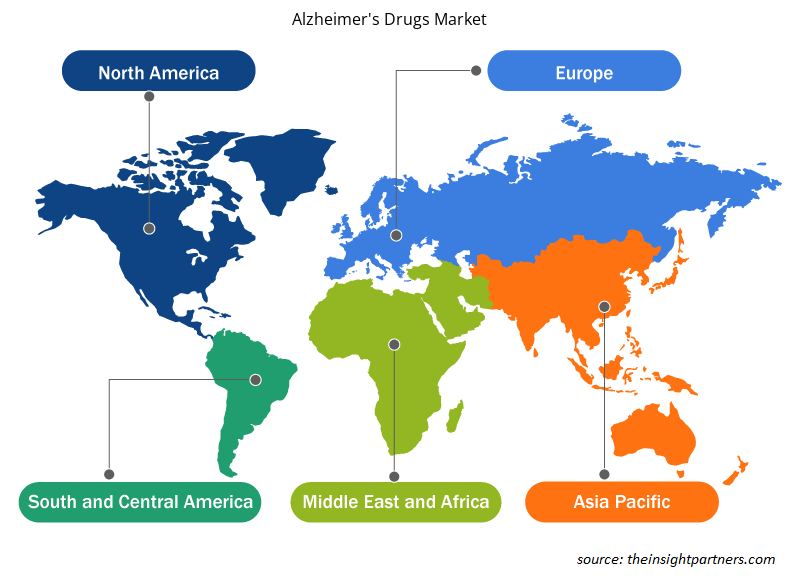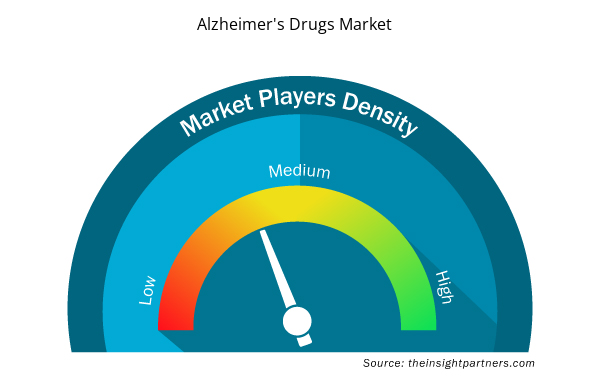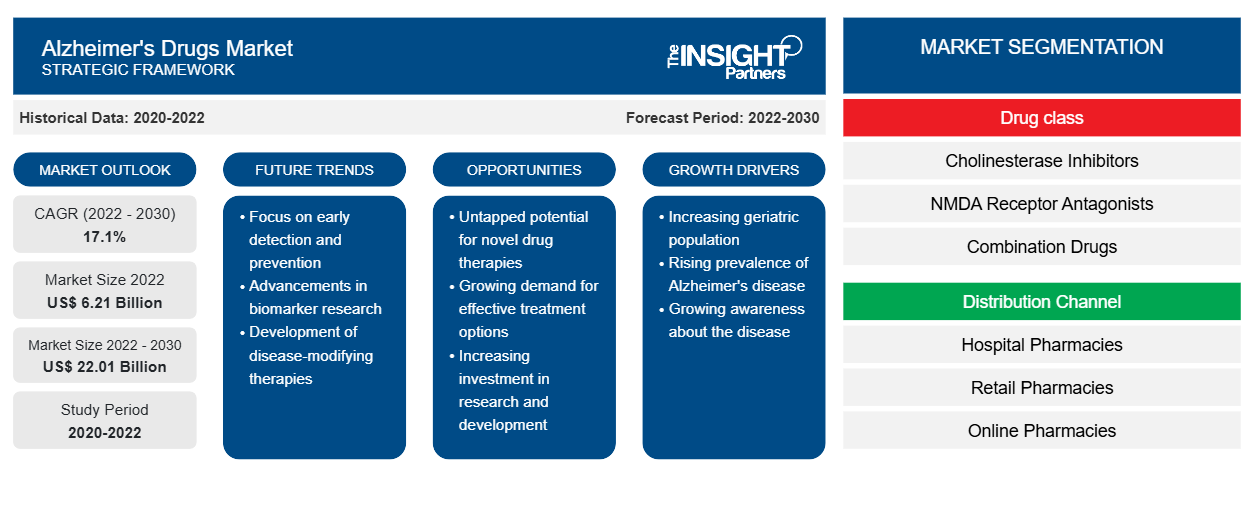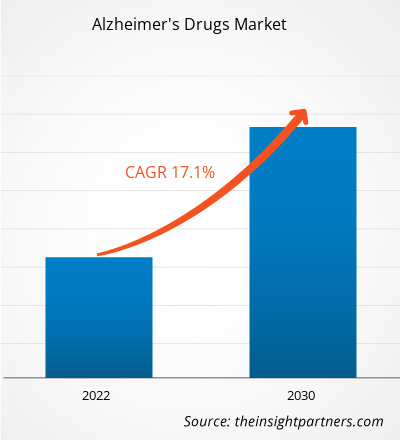[Forschungsbericht] Der Markt für Alzheimer-Medikamente soll von 6,21 Milliarden US-Dollar im Jahr 2022 auf 22,01 Milliarden US-Dollar im Jahr 2030 wachsen; für den Zeitraum 2022–2030 wird eine durchschnittliche jährliche Wachstumsrate (CAGR) von 17,1 % erwartet.
Markteinblicke und Analystenansichten:
Die Alzheimer-Krankheit (AD) ist eine neurologische Erkrankung, die durch den fortschreitenden Tod von Neuronen verursacht wird. Die Symptome beginnen allmählich und können zu Demenz führen. Obwohl die Krankheit nicht vollständig geheilt werden kann, gibt es Medikamente, die die Symptome vorübergehend lindern und das Fortschreiten der Krankheit verlangsamen können. Die hohe Prävalenz von AD, insbesondere bei älteren Menschen, und die zunehmenden Forschungs- und Entwicklungsaktivitäten der Pharmaindustrie zur Einführung von Diagnostika und Therapien für die Krankheit sind die Hauptfaktoren, die das Wachstum des Marktes für Alzheimer-Medikamente vorantreiben . Die Nebenwirkungen der Medikamente und das strenge regulatorische Umfeld behindern jedoch den Marktfortschritt. Darüber hinaus wird erwartet, dass der zunehmende Fokus auf personalisierte Behandlungen und Präzisionsmedikamente für AD in den kommenden Jahren neue Trends auf dem Markt für Alzheimer-Medikamente mit sich bringen wird.
Wachstumstreiber und -hemmnisse:
Die steigende Zahl der Fälle von Alzheimer und verwandten Demenzerkrankungen treibt den Markt für Alzheimermedikamente voran. Die Alzheimer-Krankheit ist die weltweit häufigste Form der Demenz und macht 60–70 % aller Fälle aus. Es handelt sich um eine fortschreitende neurodegenerative Erkrankung, die sich im Laufe der Jahre allmählich verschlimmert und bei der alternden Bevölkerung häufiger auftritt. Laut dem im Oktober 2022 veröffentlichten Bericht der Weltgesundheitsorganisation (WHO) wird die Weltbevölkerung im Alter von 60 Jahren und älter bis 2030 auf 1,4 Milliarden und bis 2050 auf 2,1 Milliarden anwachsen. Es wird erwartet, dass diese wachsende geriatrische Bevölkerung die Krankheitslast erhöhen und die Nachfrage nach entsprechenden medizinischen Behandlungen in den kommenden Jahren steigern wird.
Darüber hinaus sind das steigende Bewusstsein für AD, die Verbesserung der Diagnoseraten und die steigenden Investitionen in die Entwicklung neuer Behandlungen die Wachstumstreiber des Marktes. Laut einem 2021 veröffentlichten Bericht der Alzheimer's Association investierte die Vereinigung im Jahr 2020 63 Millionen US-Dollar, um die Alzheimer- und Demenzforschung voranzutreiben.
Mögliche Nebenwirkungen haben jedoch erhebliche Auswirkungen auf die Entwicklung des Alzheimer-Medikamentsmarktes. Acetylcholinesterasehemmer (AChEIs) und NMDA-Rezeptorantagonisten sind die Medikamentenklasse, die üblicherweise zur Behandlung von AD verschrieben wird. Obwohl diese Medikamente weit verbreitet sind und bei bestimmungsgemäßer Anwendung im Allgemeinen als sicher gelten, sind mit ihrer Verwendung mehrere spezifische Nebenwirkungen und Bedenken verbunden. Die bedeutendsten Nebenwirkungen von AD-Medikamenten sind Schwindel, Übelkeit, Durchfall und Bauchschmerzen im Falle einer Überdosierung oder bei unsachgemäßer Anwendung. Dies ist ein großes Problem und kann das Vertrauen der Verbraucher in das Produkt beeinträchtigen und möglicherweise zu einer geringeren Verwendung führen. Laut einem 2021 im ScienceDirect Journal veröffentlichten Artikel berichteten Studien zur Bewertung der Nebenwirkungen von Medikamenten zur Behandlung von AD von kardialen Nebenwirkungen im Zusammenhang mit AChEIs und gastrointestinalen Nebenwirkungen wie Verstopfung, Durchfall, Erbrechen und Bauchschmerzen im Zusammenhang mit Memantin . Somit behindern die Nebenwirkungen dieser Medikamente den Markt für Alzheimer-Medikamente.
Passen Sie diesen Bericht Ihren Anforderungen an
Sie erhalten kostenlose Anpassungen an jedem Bericht, einschließlich Teilen dieses Berichts oder einer Analyse auf Länderebene, eines Excel-Datenpakets sowie tolle Angebote und Rabatte für Start-ups und Universitäten.
- Holen Sie sich die wichtigsten Markttrends aus diesem Bericht.Dieses KOSTENLOSE Beispiel umfasst eine Datenanalyse von Markttrends bis hin zu Schätzungen und Prognosen.
Berichtssegmentierung und -umfang:
Die „Marktanalyse für Alzheimer-Medikamente“ wurde unter Berücksichtigung der folgenden Segmente durchgeführt: Medikamentenklasse und Vertriebskanal.
Segmentanalyse:
Basierend auf der Medikamentenklasse ist der Markt in Cholinesterasehemmer , NMDA-Rezeptorantagonisten, Kombinationsmedikamente und Pipeline-Medikamente segmentiert. Das Segment der Cholinesterasehemmer hatte 2022 den größten Marktanteil bei Alzheimer-Medikamenten. Das Segment der Pipeline-Medikamente wird voraussichtlich zwischen 2022 und 2030 die höchste CAGR verzeichnen. Das Segment der Cholinesterasehemmer ist weiter segmentiert in Donepezil, Galantamin und Rivastigmin. Cholinesterasehemmer werden von Spezialisten wie Psychiatern oder Neurologen für Alzheimer im frühen bis mittleren Stadium verschrieben. Diese Medikamente erhöhen den Acetylcholinspiegel im Gehirn, einen Neurotransmitter, der den Nervenzellen hilft, miteinander zu kommunizieren.
Basierend auf den Vertriebskanälen ist der Markt in Krankenhausapotheken, Einzelhandelsapotheken und Online-Apotheken segmentiert. Im Jahr 2022 hielt das Segment der Krankenhausapotheken den größten Marktanteil bei Alzheimer-Medikamenten. Das Segment der Online-Apotheken dürfte zwischen 2022 und 2030 die höchste durchschnittliche jährliche Wachstumsrate verzeichnen.
Regionale Analyse:
Der Umfang des Marktberichts für Alzheimer-Medikamente umfasst Nordamerika, Europa, den asiatisch-pazifischen Raum, Süd- und Mittelamerika sowie den Nahen Osten und Afrika. Im Jahr 2022 hatte Nordamerika den größten Anteil am Weltmarkt, was auf die umfangreichen Forschungs- und Entwicklungsaktivitäten der Pharmaunternehmen und die Prävalenz von AD und der damit verbundenen Demenz in der alternden Bevölkerung der Region zurückzuführen ist. Laut der Alzheimer's Association wurden im Jahr 2023 in Amerika über 6 Millionen Menschen mit AD diagnostiziert, und etwa 1 von 9 Personen im Alter von 65 Jahren oder älter – das entspricht 10,7 % der amerikanischen Bevölkerung – war von der Alzheimer-Krankheit betroffen. Darüber hinaus ist AD laut Statistiken der Centers for Disease Control and Prevention (CDC) vom Oktober 2020 die sechsthäufigste Todesursache bei Erwachsenen in den USA. Darüber hinaus steigern die steigenden Ausgaben für Gesundheitsdienstleistungen in den USA die Nachfrage nach Medikamenten zur Behandlung von AD und begünstigen das Wachstum des Marktes für Alzheimer-Medikamente in der Region.
Umfang des Marktberichts zu Alzheimer-Medikamenten
Branchenentwicklungen und zukünftige Chancen:
Die Marktprognose für Alzheimermedikamente kann den Beteiligten auf diesem Markt bei der Planung ihrer Wachstumsstrategien helfen. Nachfolgend sind einige Initiativen der wichtigsten Akteure auf dem globalen Markt für Alzheimermedikamente aufgeführt:
- Im Januar 2024 gaben Eisai Co., Ltd. und Biogen Inc. bekannt, dass der Vertrieb ihrer gemeinsamen Entwicklung LEQEMBI in China zugelassen wurde. Es handelt sich um einen humanisierten, antilöslichen, aggregierten Amyloid-beta (Aβ)-monoklonalen Antikörper, der zur Behandlung leichter kognitiver Beeinträchtigungen (MCI) aufgrund von AD und leichter AD-Demenz entwickelt wurde.
- Im Mai 2023 gaben Otsuka Pharmaceutical, Co. Ltd. und Lundbeck LLC bekannt, dass ihre gemeinsame Entwicklung, der ergänzende Zulassungsantrag (sNDA) für REXULTI mit Brexpiprazol, die Zulassung der US-amerikanischen Food and Drug Administration (FDA) zur Behandlung neuropsychiatrischer Symptome bei Alzheimer und Demenz erhalten hat.
- Im Mai 2023 gab Eli Lilly and Company das positive Ergebnis der Phase-3-Studie TRAILBLAZER-ALZ 2 seines Alzheimer-Medikaments Donanemab bekannt. Der Studie zufolge verlangsamte Donanemab den kognitiven und funktionellen Verfall bei Menschen mit frühem symptomatischen Alzheimer signifikant.
- Im September 2022 brachte Corium, Inc. ADLARITY auf den Markt, ein transdermales Donepezil-System in den USA. Es ist ein verschreibungspflichtiges Medikament zur Behandlung von leichter, mittelschwerer oder schwerer Demenz bei Patienten mit AD. Dieses transdermale System ist das erste und einzige einmal wöchentlich einzunehmende Pflaster, das gleichmäßige Dosen Donepezil über die Haut abgibt und keine gastrointestinalen Nebenwirkungen hat.
Wettbewerbslandschaft und Schlüsselunternehmen:
Pfizer Inc.; Siemens Healthcare GmbH; Teva Pharmaceutical Industries Ltd.; GlaxoSmithKline plc; Sanofi; Novartis AG; AstraZeneca; AbbVie Inc.; Eisai Co., Ltd.; und Takeda Pharmaceutical Company Limited gehören zu den prominenten Akteuren, die im Bericht zum Markt für Alzheimer-Medikamente vorgestellt werden. Darüber hinaus wurden im Rahmen der Studie mehrere andere Akteure untersucht und analysiert, um einen ganzheitlichen Überblick über den Markt und sein Ökosystem zu erhalten.
Berichtsumfang
Regionale Einblicke in den Markt für Alzheimer-Medikamente
Die regionalen Trends und Faktoren, die den Markt für Alzheimermedikamente im Prognosezeitraum beeinflussen, wurden von den Analysten von Insight Partners ausführlich erläutert. In diesem Abschnitt werden auch die Marktsegmente und die Geografie von Alzheimermedikamenten in Nordamerika, Europa, im asiatisch-pazifischen Raum, im Nahen Osten und Afrika sowie in Süd- und Mittelamerika erörtert.

- Erhalten Sie regionale Daten zum Markt für Alzheimer-Medikamente
Umfang des Marktberichts zu Alzheimer-Medikamenten
| Berichtsattribut | Details |
|---|---|
| Marktgröße im Jahr 2022 | 6,21 Milliarden US-Dollar |
| Marktgröße bis 2030 | 22,01 Milliarden US-Dollar |
| Globale CAGR (2022 - 2030) | 17,1 % |
| Historische Daten | 2020-2022 |
| Prognosezeitraum | 2022–2030 |
| Abgedeckte Segmente | Nach Arzneimittelklasse
|
| Abgedeckte Regionen und Länder | Nordamerika
|
| Marktführer und wichtige Unternehmensprofile |
|
Marktteilnehmerdichte für Alzheimermedikamente: Auswirkungen auf die Geschäftsdynamik verstehen
Der Markt für Alzheimermedikamente wächst rasant, angetrieben durch die steigende Nachfrage der Endverbraucher aufgrund von Faktoren wie sich entwickelnden Verbraucherpräferenzen, technologischen Fortschritten und einem größeren Bewusstsein für die Vorteile des Produkts. Mit steigender Nachfrage erweitern Unternehmen ihr Angebot, entwickeln Innovationen, um die Bedürfnisse der Verbraucher zu erfüllen, und nutzen neue Trends, was das Marktwachstum weiter ankurbelt.
Die Marktteilnehmerdichte bezieht sich auf die Verteilung von Firmen oder Unternehmen, die in einem bestimmten Markt oder einer bestimmten Branche tätig sind. Sie gibt an, wie viele Wettbewerber (Marktteilnehmer) in einem bestimmten Marktraum im Verhältnis zu seiner Größe oder seinem gesamten Marktwert präsent sind.
Die wichtigsten auf dem Markt für Alzheimer-Medikamente tätigen Unternehmen sind:
- Pfizer Inc.
- Siemens Healthcare GmbH
- Teva Pharmaceutical Industries Ltd.
- GlaxoSmithKline plc
- Sanofi
Haftungsausschluss : Die oben aufgeführten Unternehmen sind nicht in einer bestimmten Reihenfolge aufgeführt.

- Überblick über die wichtigsten Akteure auf dem Markt für Alzheimer-Medikamente
- Historische Analyse (2 Jahre), Basisjahr, Prognose (7 Jahre) mit CAGR
- PEST- und SWOT-Analyse
- Marktgröße Wert/Volumen – Global, Regional, Land
- Branche und Wettbewerbsumfeld
- Excel-Datensatz


- Machine Condition Monitoring Market
- Blood Collection Devices Market
- Investor ESG Software Market
- Automotive Fabric Market
- Animal Genetics Market
- Europe Industrial Chillers Market
- Pressure Vessel Composite Materials Market
- Equipment Rental Software Market
- Genetic Testing Services Market
- Single Pair Ethernet Market

Report Coverage
Revenue forecast, Company Analysis, Industry landscape, Growth factors, and Trends

Segment Covered
This text is related
to segments covered.

Regional Scope
North America, Europe, Asia Pacific, Middle East & Africa, South & Central America

Country Scope
This text is related
to country scope.
Häufig gestellte Fragen
Key factors driving the Alzheimer’s drugs market growth include the high prevalence of AD, particularly in the senior population, and growing research and development activities in the pharmaceutical industry to introduce diagnostics and therapies for the condition.
The Alzheimer’s drugs market was valued at US$ 6.21 billion in 2022.
The Alzheimer’s drugs market is expected to be valued at US$ 22.01 billion in 2030.
Alzheimer's disease (AD) is a neurological disorder caused by the progressive death of neurons. The symptoms begin gradually and can lead to dementia. Although the condition cannot be cured completely, there are medicines available that can temporarily alleviate the symptoms and slow down the progression of the disease. Drugs from the class of cholinesterase inhibitors, NMDA receptor antagonists, and combination of these two are indicated for AD.
The Alzheimer’s drugs market, by drug class, is segmented into cholinesterase inhibitors, NMDA receptor antagonists, combination drugs, and pipeline drugs. The cholinesterase inhibitors segment held a larger market share in 2022. The pipeline drugs segment is anticipated to register a higher CAGR during 2022-2030.
The Alzheimer’s drugs market majorly consists of the players such as Pfizer Inc.; Siemens Healthcare GmbH; Teva Pharmaceutical Industries Ltd.; GlaxoSmithKline plc; Sanofi; Novartis AG; AstraZeneca; AbbVie Inc.; Eisai Co., Ltd.; and Takeda Pharmaceutical Company Limited.
Trends and growth analysis reports related to Life Sciences : READ MORE..
The List of Companies - Alzheimer’s Drugs Market
- Pfizer Inc.
- Siemens Healthcare GmbH
- Teva Pharmaceutical Industries Ltd.
- GlaxoSmithKline plc
- Sanofi
- Novartis AG
- AstraZeneca
- AbbVie Inc.
- Eisai Co., Ltd.
- Takeda Pharmaceutical Company Limited
The Insight Partners performs research in 4 major stages: Data Collection & Secondary Research, Primary Research, Data Analysis and Data Triangulation & Final Review.
- Data Collection and Secondary Research:
As a market research and consulting firm operating from a decade, we have published and advised several client across the globe. First step for any study will start with an assessment of currently available data and insights from existing reports. Further, historical and current market information is collected from Investor Presentations, Annual Reports, SEC Filings, etc., and other information related to company’s performance and market positioning are gathered from Paid Databases (Factiva, Hoovers, and Reuters) and various other publications available in public domain.
Several associations trade associates, technical forums, institutes, societies and organization are accessed to gain technical as well as market related insights through their publications such as research papers, blogs and press releases related to the studies are referred to get cues about the market. Further, white papers, journals, magazines, and other news articles published in last 3 years are scrutinized and analyzed to understand the current market trends.
- Primary Research:
The primarily interview analysis comprise of data obtained from industry participants interview and answers to survey questions gathered by in-house primary team.
For primary research, interviews are conducted with industry experts/CEOs/Marketing Managers/VPs/Subject Matter Experts from both demand and supply side to get a 360-degree view of the market. The primary team conducts several interviews based on the complexity of the markets to understand the various market trends and dynamics which makes research more credible and precise.
A typical research interview fulfils the following functions:
- Provides first-hand information on the market size, market trends, growth trends, competitive landscape, and outlook
- Validates and strengthens in-house secondary research findings
- Develops the analysis team’s expertise and market understanding
Primary research involves email interactions and telephone interviews for each market, category, segment, and sub-segment across geographies. The participants who typically take part in such a process include, but are not limited to:
- Industry participants: VPs, business development managers, market intelligence managers and national sales managers
- Outside experts: Valuation experts, research analysts and key opinion leaders specializing in the electronics and semiconductor industry.
Below is the breakup of our primary respondents by company, designation, and region:

Once we receive the confirmation from primary research sources or primary respondents, we finalize the base year market estimation and forecast the data as per the macroeconomic and microeconomic factors assessed during data collection.
- Data Analysis:
Once data is validated through both secondary as well as primary respondents, we finalize the market estimations by hypothesis formulation and factor analysis at regional and country level.
- Macro-Economic Factor Analysis:
We analyse macroeconomic indicators such the gross domestic product (GDP), increase in the demand for goods and services across industries, technological advancement, regional economic growth, governmental policies, the influence of COVID-19, PEST analysis, and other aspects. This analysis aids in setting benchmarks for various nations/regions and approximating market splits. Additionally, the general trend of the aforementioned components aid in determining the market's development possibilities.
- Country Level Data:
Various factors that are especially aligned to the country are taken into account to determine the market size for a certain area and country, including the presence of vendors, such as headquarters and offices, the country's GDP, demand patterns, and industry growth. To comprehend the market dynamics for the nation, a number of growth variables, inhibitors, application areas, and current market trends are researched. The aforementioned elements aid in determining the country's overall market's growth potential.
- Company Profile:
The “Table of Contents” is formulated by listing and analyzing more than 25 - 30 companies operating in the market ecosystem across geographies. However, we profile only 10 companies as a standard practice in our syndicate reports. These 10 companies comprise leading, emerging, and regional players. Nonetheless, our analysis is not restricted to the 10 listed companies, we also analyze other companies present in the market to develop a holistic view and understand the prevailing trends. The “Company Profiles” section in the report covers key facts, business description, products & services, financial information, SWOT analysis, and key developments. The financial information presented is extracted from the annual reports and official documents of the publicly listed companies. Upon collecting the information for the sections of respective companies, we verify them via various primary sources and then compile the data in respective company profiles. The company level information helps us in deriving the base number as well as in forecasting the market size.
- Developing Base Number:
Aggregation of sales statistics (2020-2022) and macro-economic factor, and other secondary and primary research insights are utilized to arrive at base number and related market shares for 2022. The data gaps are identified in this step and relevant market data is analyzed, collected from paid primary interviews or databases. On finalizing the base year market size, forecasts are developed on the basis of macro-economic, industry and market growth factors and company level analysis.
- Data Triangulation and Final Review:
The market findings and base year market size calculations are validated from supply as well as demand side. Demand side validations are based on macro-economic factor analysis and benchmarks for respective regions and countries. In case of supply side validations, revenues of major companies are estimated (in case not available) based on industry benchmark, approximate number of employees, product portfolio, and primary interviews revenues are gathered. Further revenue from target product/service segment is assessed to avoid overshooting of market statistics. In case of heavy deviations between supply and demand side values, all thes steps are repeated to achieve synchronization.
We follow an iterative model, wherein we share our research findings with Subject Matter Experts (SME’s) and Key Opinion Leaders (KOLs) until consensus view of the market is not formulated – this model negates any drastic deviation in the opinions of experts. Only validated and universally acceptable research findings are quoted in our reports.
We have important check points that we use to validate our research findings – which we call – data triangulation, where we validate the information, we generate from secondary sources with primary interviews and then we re-validate with our internal data bases and Subject matter experts. This comprehensive model enables us to deliver high quality, reliable data in shortest possible time.


 Holen Sie sich ein kostenloses Muster für diesen Bericht
Holen Sie sich ein kostenloses Muster für diesen Bericht